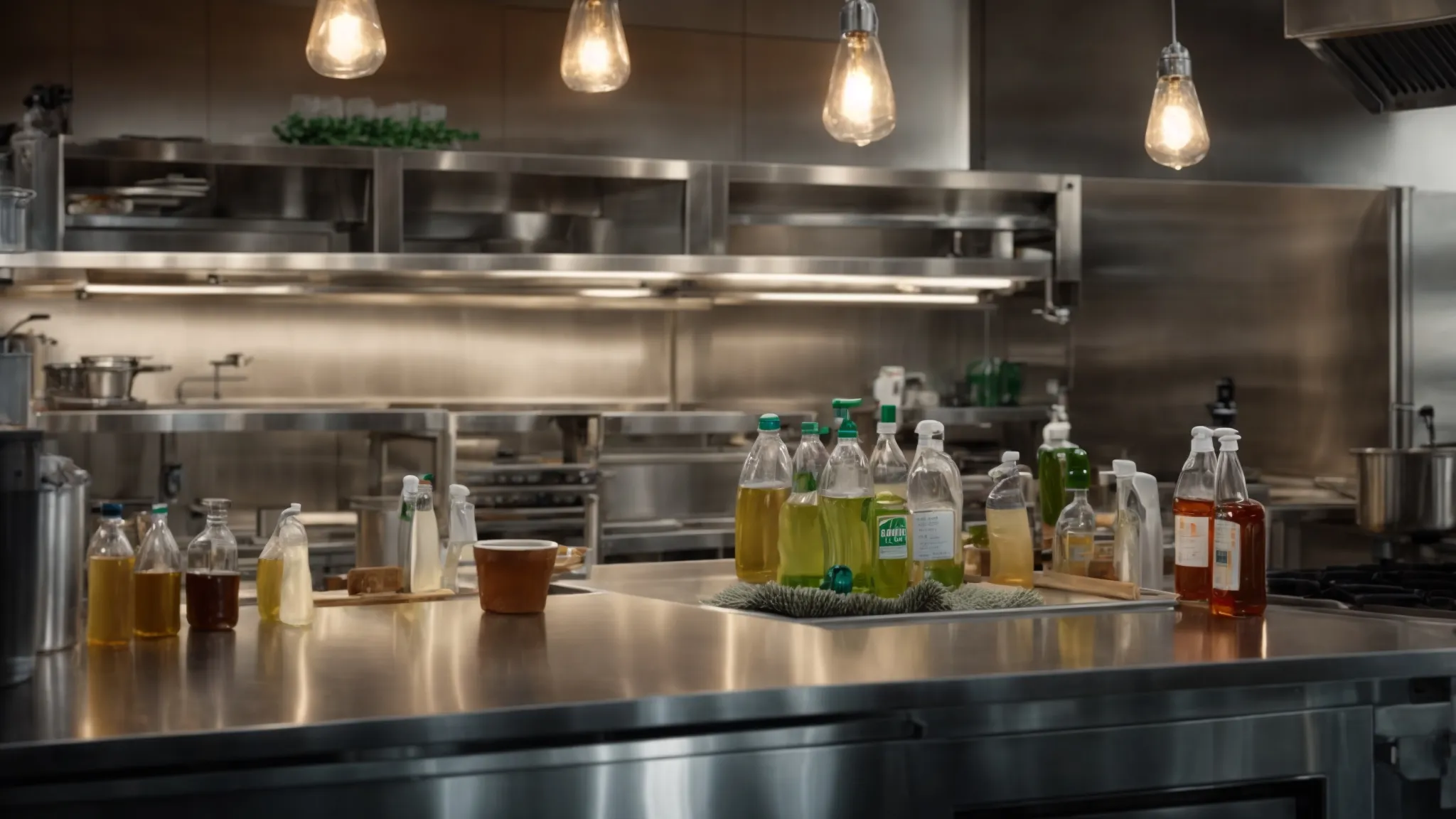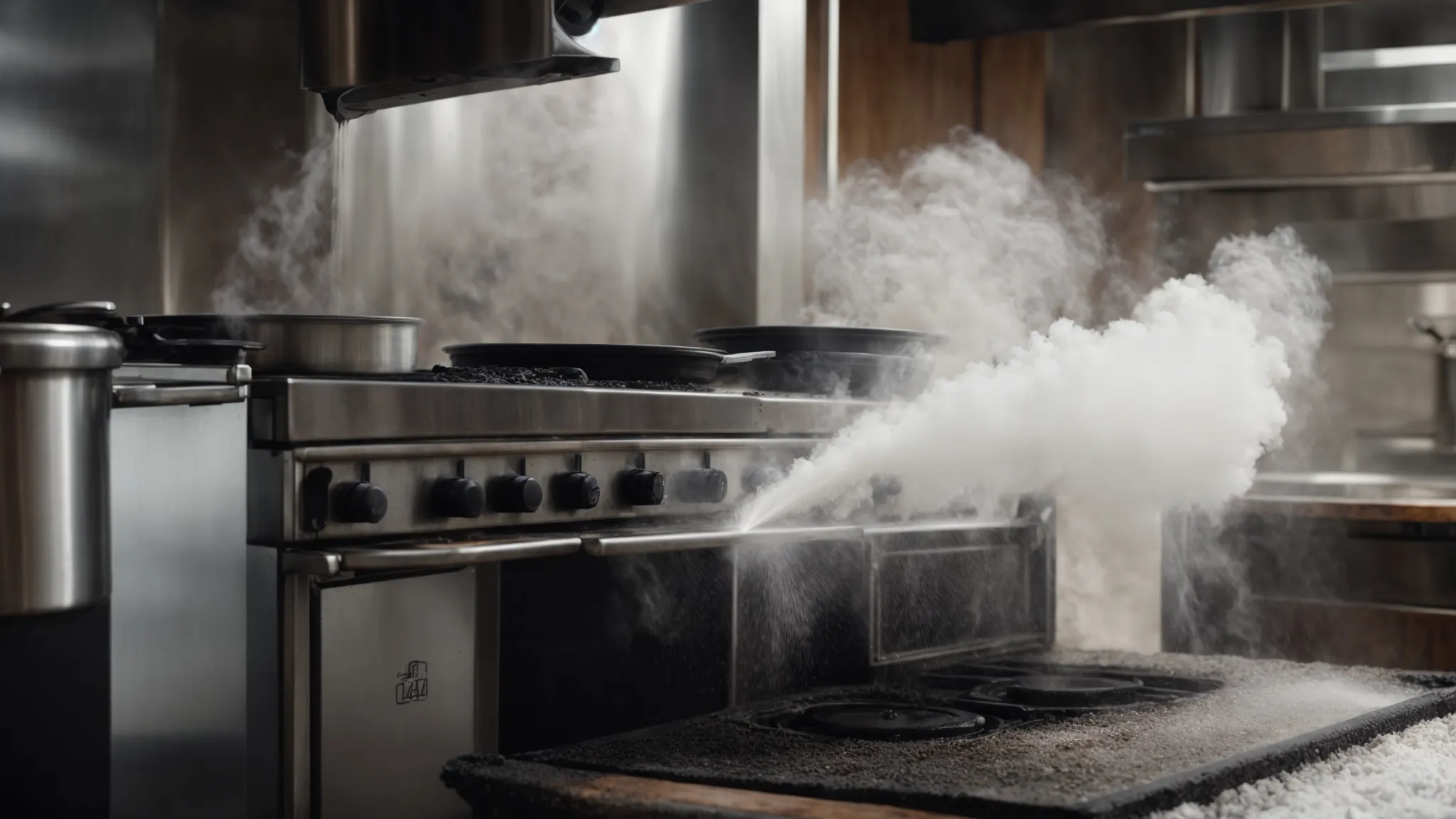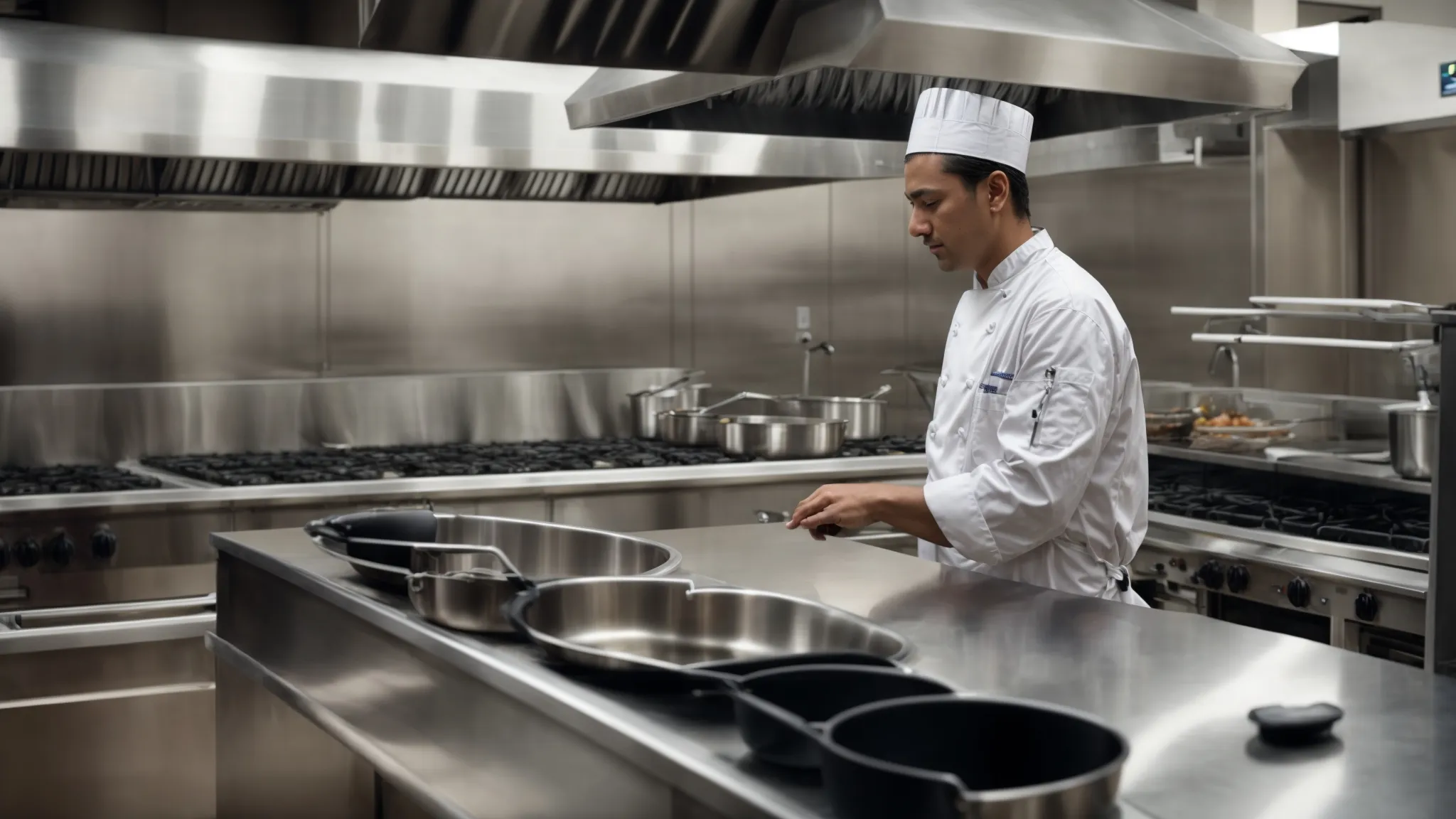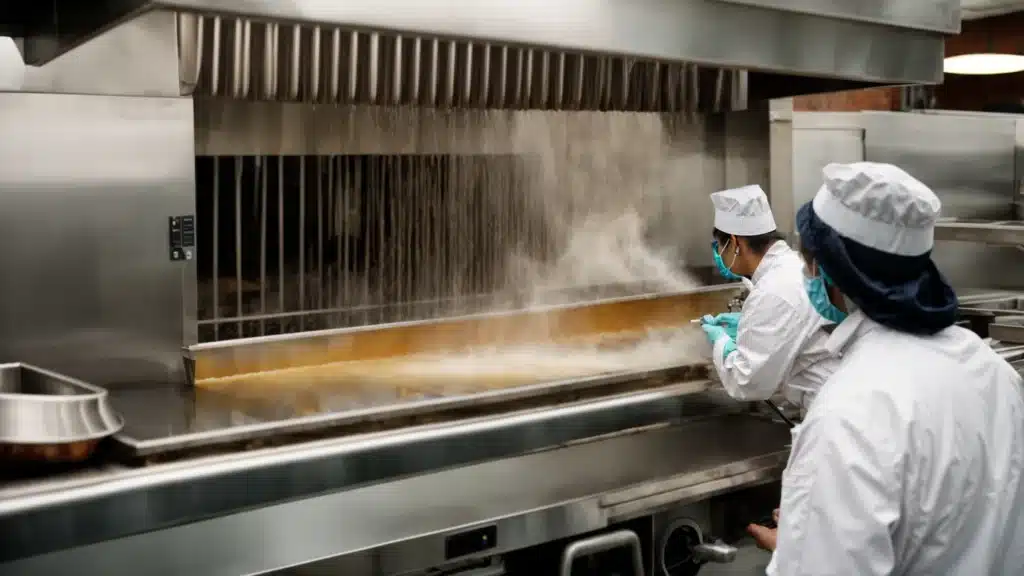The Science Behind How Hood and Kitchen Cleaning Avoid Potential Fire Disasters
In the bustling heart of Ontario’s commercial kitchens, where flames dance and delicacies are born, lurks an invisible adversary: grease.
This unassuming byproduct of culinary passion, when left unchecked, transforms into a formidable fire hazard, threatening the dreams and safety of restaurateurs.
Ontario Hood Cleaning, wielding a symphony of science and expertise, steps into this arena with precision and purpose, turning the tide against potential disasters through meticulous cleaning and maintenance.
Their arsenal, rich with chemistry and cutting-edge cleaning agents, targets the grease’s very essence, leaving no stone unturned in the quest for kitchen safety.
Keep reading to discover how this dedicated brigade champions the fight for fire safety, marrying diligence with innovation at every step.
Key Takeaways
- Professional Hood and Kitchen Cleaning Is Pivotal in Preventing Fire Disasters in Commercial Kitchens
- Regular Inspections and Maintenance of Ventilation Systems Are Crucial for Mitigating Grease Accumulation
- Utilizing the Correct Degreasing Agents and Cleaning Techniques Is Essential for Dismantling the Molecular Structure of Grease
- Adherence to Fire Safety and Health Regulations Through Professional Cleaning Can Safeguard Establishments Against Legal Liabilities and Potentially Lower Insurance Premiums
- Timely Professional Cleaning Interventions Have Prevented Potentially Catastrophic Fire Incidents, Highlighting Their Importance in Kitchen Safety
Understanding the Risk: Why Kitchen Grease Is a Fire Hazard

In the bustling heart of commercial kitchens, where aromas intertwine with the clatter of pots and pans, a silent peril lurks within the grease that graces every surface from oven to exhaust.
This seemingly innocuous byproduct of culinary artistry holds within it a complex chemical composition, a concoction ripe for ignition under the right conditions.
As grease silently accumulates, transforming from liquid splatters to a viscous layer, its presence escalates the risk of fire, crafting an invisible menace that threatens safety and serenity.
Ventilation systems, the lungs of the kitchen, play a pivotal role in this drama, as their efficiency, or lack thereof, can significantly sway the scale towards safety or disaster.
Recognizing and mitigating this hazard requires a dive into the essence of kitchen grease, an exploration of the way it amasses, and an understanding of the crucial role ventilation must play in the orchestration of fire prevention.
The Chemical Composition of Kitchen Grease
Within the bustling kitchens of Ontario’s finest dining establishments, the complex chemical composition of kitchen grease becomes a clandestine architect of risk. This seemingly benign substance is a cocktail of organic compounds, primarily consisting of fats, oils, and triglycerides, transformed by cooking processes into a highly flammable blanket that coats kitchen surfaces and equipment.
As culinary maestros paint the canvas of taste with a palette of oils and fats, these substances undergo a metamorphosis under the influence of heat. Degradation products such as free fatty acids and monoglycerides emerge, increasing the volatility of kitchen grease. This alchemical shift not only elevates the fire risk but also challenges the efficacy of conventional cleaning methods, underscoring the indispensable role of specialized hood and kitchen exhaust cleaning services in maintaining a safe cooking environment.
How Grease Accumulation Increases Fire Risk
In the theatre of commercial kitchens, the accumulation of grease is akin to stacking kindling next to an open flame: a precarious setup for potential disaster. This oily residue, when left unattended, clings to surfaces, creating a fuel source that awaits only a spark to ignite.
The escalation from a spotless kitchen to a fire hazard follows a discernible trajectory:
- Grease begins its journey as a byproduct of cooking, splattering, and settling on surfaces and ventilation systems.
- Over time, this grease solidifies, forming a thick, highly flammable layer that coats kitchen equipment and exhaust hood filters.
- A single spark or high enough heat can ignite this accumulated grease, leading to a fire that can quickly spiral out of control.
Therefore, the risk that grease accumulation poses is not just the presence of this combustible material but also the potential for rapid fire spread, turning what might be a manageable incident into a full-blown disaster.
The Role of Ventilation Systems in Fire Prevention
The backbone of fire prevention in the crucible of commercial kitchens is undeniably the ventilation system. Acting as the unsung sentinel, its primary objective is to mitigate the accumulation of grease, whisking away smoke and vapor before they settle as flammable residues on surfaces and equipment.
Through the strategic deployment of exhaust hoods and ventilators, these systems engage in a continuous battle against the invisible enemy of grease buildup. When maintained immaculately, they serve as the vanguard against potential fire incidents, ensuring that the very air in the kitchen refuses to conspire with fire’s greedy reach.
Now, let’s ignite our curiosity further and delve into the science behind the solutions. Prepare to be amazed as we explore the chemistry of cleaning agents that combat these fiery risks head-on.
The Chemistry of Cleaning Agents in Hood and Kitchen Cleaning

In the quest to fend off the specter of fire hazards in commercial kitchens, the science behind hood and kitchen cleaning unveils a tapestry woven with precision and ingenuity.
At the heart of this endeavor lies an array of cleaning agents, each harbinger to a specific role in the battle against grease and grime.
Among them, degreasers stand as titans, their chemical compositions meticulously engineered to dismantle the molecular bonds of grease, rendering it powerless.
Equally paramount is the understanding of pH levels in cleaning solutions, a subtle yet critical factor that determines the effectiveness of each agent.
This delicate balance between caustic and acidic properties ensures that while grease is eradicated, the integrity of kitchen surfaces remains unscathed.
Through the lens of science, these tools of cleanliness unfurl their effectiveness, safeguarding kitchens from the shadows of potential fire disasters.
Types of Cleaning Agents and Their Effectiveness
In the crucial endeavor of eradicating kitchen grease, the arsenal of cleaning agents is diverse, each crafted for maximum efficacy against this formidable foe. High-powered degreasers, equipped with potent formulas, penetrate the stubborn molecular structure of grease, ensuring it is not just removed but thoroughly obliterated. The effectiveness of these cleaning champions rests on their ability to break down the very essence of grease, offering a clean slate free from the whispers of fire threats.
On the other end of the spectrum, mild detergents play a pivotal role, especially on surfaces where harsh chemicals are not an option. These detergents, gentle yet determined, work tirelessly to maintain the cleanliness of kitchen areas without compromising the integrity of delicate materials. Working in symphony with degreasers, they ensure that every nook and cranny, from the stainless steel allure of an exhaust hood to the hidden corners of ventilation ducts, remains free from the grasp of grease and the looming shadow of potential fire disasters.
The Science of Degreasers Breaking Down Grease
In the heart of the battle against kitchen fires, degreasers stand as valiant warriors, their effectiveness rooted in a profound understanding of chemistry. These powerful cleaning agents wield the capability to break down the stubborn bonds that hold grease molecules together, leveraging surfactants and emulsifiers to dissolve and displace grease from kitchen surfaces and exhaust systems, making them crucial allies in the war on grease.
Deploying an intricate dance of chemical affinity and repulsion, degreasers target the lipid structures within grease, a tactic that ensures their dissolution into harmless, easily cleaned substances. This process not only purifies the kitchen environment from potential fire fuel but also enhances the efficiency of exhaust systems, maintaining the sanctity of ventilation and safeguarding the hearth of culinary creation from the specter of flame.
pH Levels and Their Importance in Cleaning Solutions
The intricate ballet of pH levels in cleaning solutions plays a critical role in the alchemy of hood and kitchen cleanliness. A judicious balance between acidic and alkaline properties ensures that cleaning agents are potent enough to tackle the stubbornness of grease while being gentle on the delicate surfaces of commercial kitchen equipment.
Understanding the importance of pH levels in cleaning solutions transcends basic cleanliness, acting as a guardian against the ignition of grease-induced fire hazards. By harnessing the power of pH-optimized detergents and degreasers, Ontario Hood Cleaning champions a methodology that not only removes the visible signs of grease but also neutralizes the invisible threat lurking within every kitchen.
Exploring the chemical ballet that powers cleaning agents opens a world of possibilities. Next, we unveil the precision-engineered processes that transform a grimy kitchen into a gleaming culinary stage.
Key Processes in Professional Hood and Kitchen Cleaning

In the disciplined arena of professional hood and kitchen cleaning, the journey towards safeguarding commercial kitchens from potential fire disasters unfolds through a meticulously structured process.
At the forefront of this crusade lies the initial inspection and grease assessment, a critical phase where the battleground is surveyed and the enemy – grease, in its varied forms and fortresses, is evaluated for its threat level.
Following this reconnaissance, the strategy evolves with the application of chemical solutions designed with precision to break down the grease’s tenacious molecular bonds.
The final assault on this greasy adversary employs high-pressure washing techniques, ensuring complete grease removal from the labyrinth of kitchen surfaces and exhaust systems.
Each step, executed with surgical precision, is integral to defusing the simmering threat of fire, embodying the commitment of Ontario Hood Cleaning to excellence in commercial kitchen safety.
Initial Inspection and Grease Assessment
The journey towards averting potential fire catastrophes in commercial kitchens begins with the keen eyes of experienced professionals conducting an initial inspection and grease assessment. This critical first step unravels the narrative of grease accumulation, allowing experts to chart a precise course of action tailored to the unique needs of each kitchen environment.
During this phase, specialized technicians employ a blend of visual inspections and advanced diagnostic tools to meticulously evaluate the extent of grease presence on surfaces and within ventilation systems. This comprehensive assessment lays the groundwork for devising a strategic cleaning regimen, aimed at dismantling the grease’s stronghold and mitigating the risk of fire with surgical precision.
Application of Chemical Solutions to Break Down Grease
Embarking on the valorous task of combating kitchen grease, the diligent application of chemical solutions marks a transformative step in professional hood and kitchen cleaning. These solutions, engineered with precise chemical properties, are designed to target and decompose the stubborn molecular structure of grease, embodying the epitome of cleaning prowess.
| Step | Process | Outcome |
|---|---|---|
| 1 | Application of Degreasing Agents | Breaking down of grease molecules |
| 2 | Surfactant Action | Emulsification and removal of grease |
| 3 | Rinse and Removal | Restoration of cleanliness and safety |
Once deployed, these potent concoctions work tirelessly, infiltrating every nook and cranny where grease seeks refuge. The chemistry at play here isn’t mere coincidence; it’s the result of years of refining formulas to ensure the utmost efficiency in eradicating grease, thus preventing it from becoming a harbinger of fire disasters.
High-Pressure Washing Techniques for Complete Grease Removal
In the grand theater of professional hood and kitchen cleaning, high-pressure washing stands out as a critical encore to the chemical degreasing performance. This robust technique employs the brute force of water at high velocities to rinse away the dislodged grease, ensuring it leaves behind no residue that could whisper tales of future fires.
The velocity at which the water strikes the greasy surfaces acts like a sculptor chiseling away at marble, methodically eradicating every speck of grime and oil. This process not only guarantees the complete removal of potential fire catalysts but also revitalizes the kitchen’s equipment and surfaces, restoring their shine and safeguarding their functionality against the threats posed by accumulated grease.
As we journey from the meticulous world of professional hood and kitchen cleaning, we prepare to turn up the heat. The battle against kitchen grease is about to meet its fiery contender.
The Role of Heat in Combating Kitchen Grease

In the relentless pursuit of kitchen cleanliness and fire disaster mitigation, heat emerges as a critical ally, harnessing its prowess to combat the stubborn layers of grease cloaking commercial kitchens.
The application of heat, especially through steam cleaning, introduces a thermal assault specifically engineered to penetrate and dissolve even the most tenacious grease build-up.
This section unfolds the dynamics of how heat, as a natural adversary to grease, can reshape the battlefield, offering a deep dive into steam cleaning—a thermal approach that not only dislodges but eradicates grease from the myriad surfaces it seeks refuge upon in hoods and kitchens.
How Heat Breaks Down Tough Grease Build-Up
In the ballet of battling kitchen grease, heat plays the role of a powerful conductor, orchestrating a thermal breakdown that no stubborn grease can withstand. The application of heat, particularly through methods like steam cleaning, introduces a level of thermal aggression that penetrates the fortress of grease accumulation, initiating a change in its physical state from a solid menace to a liquid form more easily eradicated.
This thermal intervention works by disrupting the molecular bonds that give grease its resilience, effectively stripping away its armor against traditional cleaning methods. As the grease breaks down under the influence of heat, its hold on kitchen surfaces and exhaust systems loosens, paving the way for a more thorough and efficient cleaning process that wards off the specter of flammable hazards.
Steam Cleaning: A Thermal Approach to Kitchen and Hood Cleaning
Steam cleaning emerges as a sophisticated vanguard in the annals of hood and kitchen cleansing, deploying the force of vaporized water to infiltrate the bastions of grease accumulation. This method harnesses the indomitable power of heat, effectively disbanding the molecular camaraderie that lends grease its formidable resilience, rendering it susceptible to thorough eradication.
In this battle against potential fire hazards, steam cleaning transcends traditional tactics by providing a deep, penetrating cleanse without the use of harsh chemicals. The technique introduces a new paradigm in kitchen safety, where the application of steam not only dislodges stubborn grease but ensures it is cleansed away, leaving behind surfaces that gleam with purity and an environment bereft of fire risk.
Harnessing the power of heat transforms the battlefield against kitchen grease. Yet, the true victory lies in our next chapter: unveiling the arsenal of preventative measures and regular maintenance.
Preventative Measures and Regular Maintenance Schedules

In the intricate ballet of preventing kitchen fires, the rhythm of routine emerges as the unsung hero, guiding the dance of safety and cleanliness.
Crafting a meticulous cleaning schedule that aligns with the cadence of kitchen use, performing regular inspections, and ensuring the optimal operation of kitchen exhaust systems form the core trifecta of preventative measures.
These strategies, when implemented with precision and consistency, build a robust defense against the insidious threat of grease-induced fires.
Through the lens of science and the discipline of regular maintenance, these interventions act as the guardians of culinary sanctuaries, ensuring the flame of creation burns solely in the hearths for which they are intended.
Creating a Cleaning Schedule Based on Kitchen Usage
In the grand tapestry of maintaining commercial kitchen safety, tailoring a cleaning schedule to mirror the specific usage patterns of each kitchen emerges as a linchpin strategy. This bespoke approach ensures that high-traffic periods are followed by comprehensive cleaning routines, effectively minimizing the risk of grease accumulation and thereby reducing the threat of potential fire disasters.
Adapting cleaning frequencies to correlate directly with the intensity of kitchen operations allows for a dynamic defense mechanism against grease-related hazards. This methodical adaptation ensures that resources are optimally allocated, guaranteeing that the kitchens remain not just operational, but safe and compliant with regulatory standards, thus safeguarding the establishment from the perils of fire outbreaks.
Importance of Regular Inspections and Maintenance
Regular inspections and maintenance stand as the cornerstone of fire-prevention strategy in commercial kitchens. They act not only as a measure to assess the current state of cleanliness but also to preemptively identify areas where grease accumulation could pose a significant fire hazard.
Maintaining a proactive approach to these inspections ensures the longevity and efficiency of exhaust systems, preventing the buildup of hazardous substances that could ignite under the right conditions. This periodic scrutiny is pivotal in preserving a safe kitchen environment, steering clear of any fire-related disasters.
- Conducting comprehensive evaluations of hood and kitchen cleanliness.
- Identifying potential trouble spots for grease accumulation.
- Implementing corrective actions to mitigate fire risks.
- Maintaining exhaust systems for optimal performance.
- Establishing a routine cleaning schedule based on the assessments.
Installing and Maintaining Kitchen Exhaust Fan Systems
In the crusade against the hidden dangers of kitchen grease, the installation and routine upkeep of kitchen exhaust fan systems stand as bulwarks of prevention. This strategic measure ensures the continuous extraction of hot air, smoke, and vapor-laden with grease from the cooking area, thereby mitigating the risk of grease accumulation that could escalate into a fire disaster.
Maintaining these systems involves regular inspections and cleaning to ensure their optimal performance. By preventing blockages in the ducts and ensuring the fan operates at peak efficiency, these actions fortify the kitchen’s defenses against the threat of fire, embodying a proactive approach to safety and compliance.
- Installation of kitchen exhaust fan systems to efficiently vent out smoke and grease.
- Regular inspections to identify any potential issues or blockages in the ductwork.
- Comprehensive cleaning of the exhaust systems to maintain optimal air flow and grease removal.
- Ensuring the exhaust fan’s motor and components are in good working condition for maximum efficiency.
- Adhering to a maintenance schedule that aligns with the intensity of kitchen usage, providing an extra layer of safety against grease-induced fires.
Shifting our focus, we embark on a vital subject that marries diligence with safety: the profound influence of professional hood cleaning on fire safety protocols. This pivotal shift illuminates a path where caution meets compliance, ensuring a safeguarded kitchen environment.
The Impact of Professional Hood Cleaning on Fire Safety Standards

In the realm of commercial kitchens, where the fine balance between culinary creation and safety teeters on the edge, professional hood and kitchen cleaning emerge as unsung heroes in upholding stringent fire safety standards.
This critical intervention not only ensures compliance with existing fire safety and health regulations, thereby fortifying establishments against the threat of legal liabilities, but also serves as a pivotal factor in the potential reduction of insurance premiums through the demonstration of diligent risk management.
Through a series of illuminating case studies, we delve into concrete examples where the timely intervention of professional cleaning services has circumvented looming disasters, drawing a clear line between regular maintenance and the aversion of catastrophic fire incidents.
As we explore these facets, the indispensable value of professional hood and kitchen cleaning in safeguarding both the physical premises and the financial health of food service operations comes sharply into focus.
Compliance With Fire Safety and Health Regulations
In the intricate weave of commercial kitchen operations, compliance with fire safety and health regulations acts as the golden thread that maintains the integrity of the culinary tapestry. Professional hood and kitchen cleaning services, with their nuanced understanding of the regulatory landscape, ensure that establishments not only meet but often exceed these standards, securing a fortress of safety against the hazards of fire.
By meticulously adhering to the guidelines laid out by fire safety and health authorities, professional cleaning teams serve as the guardians of a restaurant’s compliance status. This vigilant stewardship over the cleanliness and safety of kitchen environments directly influences an establishment’s standing with regulatory bodies, effectively shielding it from the repercussions of non-compliance, including potential legal liabilities and fines.
Reducing Insurance Premiums Through Regular Cleaning
Regular hood and kitchen cleaning not only upholds the highest standards of cleanliness and safety but also positions establishments to potentially lower their insurance premiums. Insurers often assess the level of risk associated with commercial kitchens, factoring in the vigilance applied to fire hazard reduction strategies, including the frequency and thoroughness of cleaning protocols.
By demonstrating a commitment to prevent grease buildup and the associated fire risks through scheduled professional cleanings, businesses can influence their risk profiles in the eyes of insurers. This proactive approach can lead to more favorable insurance terms, reflecting the diminished likelihood of fire incidents and claims arising from kitchen operations.
Case Studies: How Professional Cleaning Averted Potential Disasters
In one illustrative case, a bustling Toronto restaurant faced a near-disastrous scenario when a routine inspection by Ontario Hood Cleaning unveiled a significant grease buildup in the ventilation system. Immediate professional cleaning intervention prevented what could have easily escalated into a fiery catastrophe, safeguarding not only the establishment’s physical infrastructure but also its reputation among patrons.
Another instance involved a high-end banquet hall in Mississauga, where the diligent application of degreasing agents and high-pressure washing techniques by seasoned experts removed years of neglected grease accumulation. This preemptive action averted potential fire hazards, highlighting the critical role that professional hood and kitchen cleaning plays in maintaining fire safety standards and ensuring uninterrupted operations.

